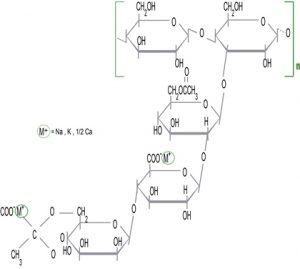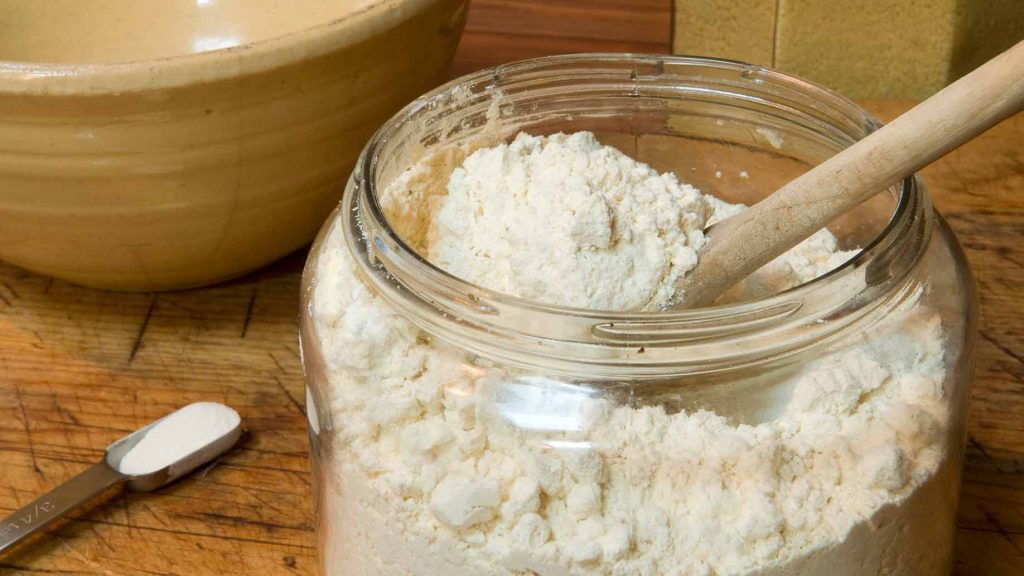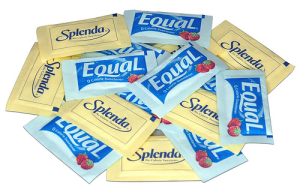What is Xanthan gum E415?
Xanthan gum E415 food additive is a widely used polysaccharide and can be used in food as an emulsifier, stabilizer, gel thickener, sizing agent, and film forming agent. It is a white light or yellow light powder. Xanthan gum E415 can be made from a range of simple sugars like glucose, sucrose, or lactose through fermentation manufacturing process using the bacteria Xanthomonas campestris. It is mainly composed of D-glucose, D-mannose, D-glucuronic acid and acetyl. Xanthan gum is soluble in cold or hot water, but not soluble in organic solvent.
Xanthan gum E415 is high in molecular weight (1-2 million). It hydrates quickly once dispersed and provides water binding resulting in very high viscosity solutions at low concentration. Its rheological behavior enables Xanthan gum to contribute to good sensory qualities, including mouth-feel and flavor release in food.
Due to its special macromolecular structure and colloidal properties, it has a variety of functions and can be used in food as an emulsifier, stabilizer, gel thickener, sizing agent, and film forming agent.
Other names for Xanthan gum: vegetable gum 415, e415 additive, thickening agent 415
Other information for Xanthan Gum
- E number: E415
- Chemical formula: (C35H49O29)n
- Molecular weight: 933 * N
- Cas number: 11138-66-2
Xanthan gum density: the density of Xanthan gum powder depends on the mesh size. Common mesh size in market is 80mesh and 200mesh, the density of 80mesh is big than 200mesh.
Xanthan gum structure
The primary structure of xanthan gum consists of repeating pentasaccharide units consisting of two D-glucopyranosyl units, two D-mannopyranosyl units and one D-glucopyranosyluronic.

Xanthan gum Manufacturing process
Production of xanthan gum E415 by fermentation process using the bacteria Xanthomonas campestris. The fermentation medium contains a carbohydrate (such as sugar), a nitrogen source, trace elements, and other growth factors. purified by recovery with ethanol or isopropanol, dried and milled.
Xanthan gum E415 Properties
Xanthan gum E415 is very resistant to pH-variations and is therefore stable in both alkaline and acidic conditions. The thermal stability of xanthan gum is usually superior to most other water-soluble hydrocolloids. Its viscosity recovers after heat treatment steps during food processing, such as sterilisation or pasteurisation. Thus the rheological properties of the final products remain stable, irrespective of being kept in a refrigerator, stored at room temperature, or heated. Xanthan gum also improves the freeze/thaw stability of frozen foods. Details Xanthan Gum properties as follows:
- Xanthan gum solubility: Soluble in hot and cold water, insoluble in alcohol
- High viscosity at low concentration.
- High pseudoplasticity. It is also called shear thinning. Pseudoplasticity is important in contributing good sensory qualities and flavor release to foods, as well as long term shelf stability of emulsifying and suspending. The viscosity of xanthan gum solutions decreases with higher shear rates; this is called shear thinning or pseudoplasticity. This means that a product subjected to shear, whether from mixing, shaking or even chewing, will thin out, but, once the shear forces are removed, the food will thicken back up.
- xanthan gum ph stability: Very resistant to pH variations: they are stable in both alkaline and acidic conditions. Between pH 1 to 13, the viscosity of xanthan solution is practically constant. At pH 9 or above, xanthan is gradually deacetylated, but this has little effect on its solution properties.
- Highly resistant to temperature variations.
- High stabilizing properties.
- Excellent freeze/thaw stability.
- Highly resistant to enzymatic degradation.
- Compatible with all commercial thickeners and stabilizers.
Xanthan gum E415 taste
Xanthan gum E415 viscosity
The factors that affect the viscosity of xanthan gum solution include concentration, temperature, salts and PH.
Effects of concentration on Viscocity
At low concentrations xanthan gum displays the unusually high viscosities important to its suspension-stabilizing properties.
xanthan gum’s high degree of pseudoplasticity. Pseudoplasticity is important in contributing good sensory qualities and flavor release to foods, as well as long term shelf stability of emulsifying and suspending.
Effects of Temperature on Viscocity
The viscosity of xanthan gum solution is affected by both the dissolving temperature and the measured solution temperature. Like most kinds of solutions, it decreases as the solution temperature rises. Xanthan gum solutions are unique in their ability to retain their viscosity until a definite “melting temperature” (Tm) is reached. At this temperature, the viscosity drops sharply due to a reversible molecular conformation change. Figure 10b shows this melting temperature for several sodium chloride concentrations. Note that the sample prepared in with 5% NaCl has a melting temperature greater than 100°C. Upon cooling, all samples revert to their original high viscosity.
Effects of Salts on Viscocity
How salts affect viscosity depends on the concentration of xanthan gum in solution. At or below about 0.25% gum concentration, monovalent salts such as sodium chloride cause a slight decrease in viscosity. At higher gum concentrations, viscosity increases with added salt. At a sodium chloride level of 0.1%, the viscosity plateau is reached, and further addition of salt has no effect on viscosity.
Many divalent metal salts, including those of calcium and magnesium, have a similar impact on viscosity.
Effects of PH Value on Viscocity
Compared with other factors, pH has little effect on the viscosity of xanthan gum solutions. When the PH value is below 3, pyruvic acid and acetyl will begin to strip. While it is over 9, the acetyl on the side chain will be stripped. High viscosity is maintained over the pH range 2-12, with some reduction at extreme pH values.
Xanthan gum gel
xanthan gum is mostly used as thickener and stabilizer. It seldom used form gel alone as its weak gel strength or almost non gel strength. Xanthan gum has a synergistic increase gel strength when used with galactomannans, particularly locust bean gum (gel formation) and guar gum (higher viscosity).
Food Grade Xanthan gum Nutritional Value
Per 100g
| Total calories |
320
|
| Total fat, g | 0 |
| Cholesterol, mg | 0 |
| Sodium, mg | 860 |
| Potassium, mg | 2800 |
| Total Carbohydrate, g | 80 |
| Dietary Fiber, g | 80 |
| Soluble fiber, g | 80 |
| Sugars, g | 0 |
| Other Carbohydrate, g | 0 |
| Protein, g | 0 |
| Vitamins: | 0 |
| Calcium, mg | 140 |
| Phosphorus, mg | 160 |
| Magnesium, mg | 72 |
| Moisture, g | 12 |
| Ash, g | 8 |
Xanthan gum E415 benefits
Why use xanthan gum E415?
Xanthan gum is used as a thickening agent and a stabilizer to prevent separation of ingredients. It is a common food additive that you find in many food from sauces and dressings to ice cream and yogurt and, of course, gluten-free baked goods.
Xanthan gum skin care benefits
You may find Xanthan Gum some Skin care products, like lotions, creams, face masks and packs
Xanthan Gum is used as a binder, emulsion stabilizer, emulsifying surfactant, as well as an aqueous viscosity increasing agent in cosmetics and personal care products because of its capability to hold water, enhance freeze-thaw stability, and improve shelf life and help with the stabilization of a product. A polysaccharide derived from glucose or sucrose (sugars), Xanthan Gum is able to increase the viscosity of liquids even when used at less than 1% concentration. It is also thought to have skin-conditioning properties.
Source: https://www.truthinaging.com/ingredients/xanthan-gum
Xanthan gum help weight loss
Xanthan is a complex carbohydrate – an indigestible fiber, to be precise. One teaspoonful of xanthan gum should ideally contain 7gm of fiber. As we all know, consumption of increased amount of fiber is likely to inhibit the absorption of fat present in ingested food.
Source: https://www.dietpillswatchdog.com/xanthan-gum-for-fat-loss/
E415 Xanthan gum Use and Application
How to use Xanthan gum E415?
Xanthan gum E415 dissolves completely in most water-based phase systems. Due to its strong hydrophilicity, if Xanthan Gum directly add to water while stirring is not sufficient, the outer layer will swell and swell into a micelle, thereby preventing the water from entering the inner layer and affecting the exertion. How to use Xantahn gum as follows: Take a quantity of xanthan gum and use 10 or more other dry ingredients, such as sugar, monosodium glutamate, salt, etc., in the food preparation and mix thoroughly. Then slowly pour in the stirring water, soak it for about two hours, and continue stirring until it is completely Dissolved.
What is the use of Xanthan gum E415?
Xanthan gum can be used in beverages, bread, dairy products, meat products, jams, jelly, sauce, noodles, cakes, cookies, biscuits, shortening, instant coffee, fish products, ice cream and so on. Xanthan gum is an ideal thickener, emulsifier and forming agent in the food industry and is used in a wide range of applications.
As a cake quality improver, xanthan gum can increase the volume of the cake, improve the structure of the cake, make the size of the cake even, flexible, and delay aging, extend the shelf life of the cake. Adding a small amount of xanthan gum to cream products and dairy products can make the product structure solid, benefit slice, and easier to release the flavor, refreshing taste. It can be used in beverages to provide beverages with excellent taste and impart refreshing characteristics to beverages, so that the insoluble components in the juice beverages form a good suspension and keep the liquid even without delamination. Xanthan gum is also widely used in foods such as canned foods, ham sausages, biscuits, cookies, snacks, instant noodles, jelly, and meat products.
Xanthan gum use in health care and cosmetic products:
Hair Colors – Xanthan gum suspends pigments.
Shampoos – Xanthan gum prevents separation on storage of anti-dandruff agents (e.g., zinc pyrithione, selenium sulfide) and silicone conditioning agents.
Toothpaste – Xanthan gum produces a glossy, relatively soft paste, which can be packaged in pump dispensers and laminated tubes. Xanthan is compatible with all normal ingredients, including baking soda and the salts used in pastes for sensitive teeth.
How much Xanthan gum E415 to use in food?
- Xanthan Gum in Fruit juice, usage 0.1-0.3%, use function thickening suspension, smooth taste, natural flavor
- Xanthan Gum in Ice cream/pudding, usage 0.1-0.3%, use function microporous, no ice, shortening the aging time, delicate product organization
- Xanthan Gum in Soy sauce and oyster sauce or Jam, usage 0.05-0.1%, to make a good salt tolerance, increased consistency, suitable for sauces, enhanced wall-hanging and adhesion
- Xanthan Gum in Frozen sweets, usage 0.1-0.2%, in combination with water, producing consistency and fineness, preventing dehydration
- Xanthan Gum in Baking Food, usage 0.5-1.5%, Fruit filling, suitable for various fillings
- Xanthan Gum in Gel, usage 0.5-1.5%, dessert gel, seasoning, jelly molding
- Xanthan Gum in Soft Drinks, usage 0.01-0.3%, used as Suspending Agent, Foam Booster, No Layering, Thickening
- Xanthan Gum in Salad seasoning, usage 0.1-0.3%, facilitates shaping and prevents water from diluting
- Xanthan Gum in Instant Noodles, usage 0.2-0.3%, Increases toughness, improves chewing, saves fuel, and maintains moisture
- Xanthan Gum in Sausage, usage 0.2-0.3%, facilitates molding, improves enema, maintains moisture and oiliness
- Xanthan Gum in Canned meat, usage 0.1-0.2%, for easy seasoning and freezing of soup
- Xanthan Gum in Cheese, usage 0.2-0.5%, accelerates pore condensation and prevents syneresis
- Xanthan Gum in Cake, usage 0.1-0.3%, increase microporous, soft, extended shelf life
- Xanthan Gum in Bread, usage 0.1-0.2, Soft, best suited for dark bread with crude fiber
- Xanthan Gum in Dehydrated Food, usage 0.2-0.4%, Accelerate Recovery, Maintain Color Taste
- Xanthan Gum in Medicine, make-up usage 0.2-1.0%, setting agent, suspending agent, moisturizer, with thickening, adhesion, lubrication
- Xanthan Gum in Toothpaste, usage 0.4-0.6%, Easy to mold toothpaste paste, improve brushing properties of toothpaste, good dispersion, smooth taste
- Xanthan Gum usage 0.1-0.3% in cans for pets
- Xanthan Gum in Fish and shrimp feed, usage 0.5-2.0%, binder, used in fish and shrimp seedling feed, fish medicine
E415 Xanthan gum Maximum usages level in food products
| Food | Maximum Level |
| Buttermilk (plain) | 3000 mg/kg |
| Fermented milks (plain), heat-treated after fermentation | 5000 mg/kg |
| Pasteurized cream | GMP |
| Sterilized, UHT, whipping or whipped, and reduced fat creams | 5000 mg/kg |
| Butter and concentrated butter | 5000 mg/kg |
| Pre-cooked or dried pastas and noodles and like products | 4000 mg/kg |
| Frozen fish, fish fillets, and fish products, including mollusks,
crustaceans, and echinoderms |
5000 mg/kg |
| Frozen battered fish, fish fillets, and fish products, including
mollusks, crustaceans, and echinoderms |
GMP |
| Liquid egg products | GMP |
| Frozen egg products | GMP |
| Other sugars and syrups (e.g., brown sugar, maple syrup) | 5000 mg/kg |
| Weaning foods for infants and growing children | 20000 mg/kg |
| Canned or bottled (pasteurized) fruit juice | 5000 mg/kg |
| Canned or bottled (pasteurized) fruit nectar | 3000 mg/kg |
Is Xanthan gum E415 safe?
Lots of investigations with respect to toxicology and safety on rats and dogs shown that xanthan gum E415 is a safe food additive. On the basis of these studies Xanthan gum was cleared by the US Food and Drug Administration (FDA) in 1969, permitting use of Xanthan gum E415 in food products without any specific quantity limitations. FDA regulations permit addition of Xanthan gum to many standardized foods such as cheese, cheese products, milk and cream products, dressings, table syrups etc. The USDA regulations permit its use in sauces, gravies and breadings used with meat and poultry products. The Canadian Governor-in-Council has also approved general use of Xanthan gum in food. Xanthan gum E415 is on Annex-I of the European Economic Community emulsifier/stabilizer list as item E415. Our Food grade Xanthan gum 80mesh, 200mesh fully meets the standards and specifications issued in the latest versions of USP-NF (United States Pharmacopeia-National Formulary), Ph. Eur. (European Pharmacopoeia), FCC (Food Chemicals Codex) and the respective EU Regulations.
Xanthan gum E415 side effects
Commonly E415 Xanthan gum is used as a safe Thickening agent, stabiliser and emulsifier in food. Xanthan gum is safe when up to 15 grams per day are taken. It can cause some side effects such as intestinal gas (flatulence) and bloating. People who are exposed to xanthan gum powder might experience flu-like symptoms, nose and throat irritation, and lung problems.
Other reported side effects like migraines or skin irritation. Its other side effects also include intestinal gas, flatulence, diarrhea and bloating. Increased taken Xanthan gum can make the symptoms worse.
Xanthan gum Market
Xanthan gum E415 manufacturers
China is the big Xanthan gum E415 manufacturers and export country in the world.
There are several Xanthan gum E415 manufacturers in China and abroad, as you know, the price of China suppliers can be better than abroad manufacturers. We have worked with China top manufacturer for years, we would like to recommend this Xanthan gum E415 brand to you if you would like to save your purchasing cost with the same quality compared with abroad manufacturers. Xanthan gum E415 Samples are available if you need it for further test after accept the price.
Key manufacturers in the global xanthan gum market include Danisco, Cargill, Jungbunzlauer, CP Kelco, Fufeng and Meihua.
Xanthan gum E415 price
As you know, there are many types of Xanthan gum E415 in the market, the price is based on different type. Now the price of Xanthan gum E415 is around USD/kg from China manufacturers and suppliers.
Where to buy Xanthan gum E415
All the products listed in our website are from the manufacturers we have worked together for many years. The professional working experience backup our confidence to their quality. We can supply Xanthan gum E415 for many Specifications and we can be your suppliers in China.
By using the appropriate Xanthan gum types in your food, the formulator can create suitable viscosity. In addition to offering standard types, we works in conjunction with customers to develop new Xanthan gum types for specific applications.
We’re committed to the quality and safety of our ingredients. We know that our customers expect us to use only the highest quality and healthiest ingredients available, and we do everything we can to satisfy those expectations. We feel confident in our choice to choose top Xanthan gum manufacturer brand.
If you have any other questions, please email us through: info@foodsweeteners.com
Xanthan gum grades in the market: Xanthan gum usp/fcc: As a xanthan gum manufacturer and supplier, we can offer xanthan gum food grade FCC and pharmaceutical grade USP. Food grade Xanthan gum FCC and USP. 80mesh and 200mesh. Transparent Xanthan gum.
Xanthan gum kosher/halal: As a manufacturer and supplier of Xanthan gum, we can supply kosher and halal certificated Xanthan gum.
Xanthan gum E415 market trend
A mounting demand for gluten-free foods is driving the xanthan gum market. Xanthan gum is used in the gluten-free baking process for several products such as cookies, cakes and pancakes, muffins and quick breads, breads, pizza dough, and salad dressings. Among these, xanthan gum is used in large quantities in the preparation of pizza dough. The nutritional characteristic of xanthan gum further increases its acceptability, as it contains carbohydrates and fiber.
The Increasing using Xanthan gum in cosmetic and healthcare are expected to provide an anticipated boost to the global xanthan gum market in future.
Xanthan gum E415 FAQ
Does xanthan gum have gluten?
No, xanthan gum is gluten free.
Xanthan gum calories
It has 320 calorie per 100g
Is Xanthan gum natural?
Xanthan gum is made from fermentation, it is not natural if strictly speaking.
What does xanthan gum look like?
Xanthan gumis a white light or yellow light powder.





